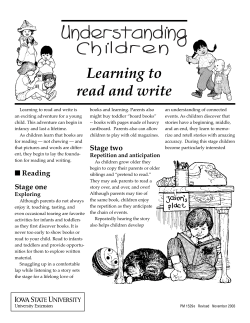
Infants and Children with Bronchiolitis GP Summary
Evidence-Based Guideline for Diagnosis and Management of Infants and Children with Bronchiolitis GP Summary Bronchiolitis is commonly caused by respiratory syncytial virus (RSV) but may also be caused by parainfluenza, adenovirus and influenza. Most bronchiolitis occurs in autumn and winter, however because some types of parainfluenza virus are present in other months, bronchiolitis can be seen year round. How do I know it’s bronchiolitis? If an infant <18 months presents with initial signs and symptoms of an upper respiratory tract infection, followed by • cough • tachypnoea • inspiratory crepitations • wheeze they are likely to have bronchiolitis. Should I do any routine investigations? No, the diagnosis of bronchiolitis is clinical; no diagnostic test confirms the disease. Chest x-rays should not be used to diagnose bronchiolitis but may occasionally be warranted in infants and children where the diagnosis is uncertain or those with severe respiratory distress, or who are at high risk of severe illness. What other things might it be? In an infant or child with bronchiolitis-like symptoms who has: Recurrent wheezing, particularly without symptoms of a viral infection or at an older age Cough as the predominant symptom and does not have wheeze, fever or crackles Persistent, or repeated and prolonged, respiratory symptoms and failure to thrive Sudden onset of symptoms, history of a coughing or choking episode, expiratory wheeze, loss of voice, or differential air entry A cardiac murmur, failure to thrive, oedema or a history of slow onset of symptoms Localising signs or more severe symptoms Consider: Asthma Pertussis, particularly if the infant or child is unimmunised, or partially immunised Cystic fibrosis An inhaled foreign body Congestive heart failure Bacterial pneumonia. An infant or child with bronchiolitis may also have viral pneumonia. Differentiating between bronchiolitis and viral pneumonia is difficult and largely unnecessary as treatment in either case is supportive. Should all infants with bronchiolitis be given a trial of β2agonist bronchodilators? Consider a trial of a single dose of β2agonist bronchodilators in patients older than 9 months, particularly those with recurrent wheezing. An infant or child with bronchiolitis-like symptoms who responds to treatment with a bronchodilator, such as salbutamol, is likely to have asthma and should be treated according to asthma management guidelines. How long will the symptoms last? Median duration of illness is 2 weeks. Approximately 20% of patients have symptoms longer than 3 weeks Based on the Southern Health Evidence-Based Guideline for the Management of Bronchiolitis, 2006 available at www.healthforkids.net.au How do I assess severity? Mild • Normal respiratory rate Moderate • Increased respiratory rate • Subtle or no accessory muscle use • Minor accessory muscle use • Normal heart rate • Increased heart rate • Able to feed • Minor dehydration • Some limitation of ability to feed • Crepitations Severe • Markedly increased respiratory rate • Moderate/marked accessory muscle use • Nasal flare or grunting • Markedly increased heart rate • Marked dehydration • Unable to feed • Toxic appearance • Sweaty • Irritable Life threatening • Maximal accessory muscle use/exhaustion • Poor respiratory effort • Apnoeas • Cyanosis Infants with symptoms across categories should be treated according to their most severe features Infants who are <3 months old or who were born at <36 weeks gestation, and those with an underlying cardio-respiratory condition are at higher risk of more severe disease. Infants not tolerating oral feeds may need nasogastric or intravenous fluids. Those with increased work of breathing or decreased oxygenation during feeds require oxygen. What should I do? In mild or moderate cases tolerating feeds and not requiring O2 • Suggest small, frequent feeds • Provide parent information • Offer review In moderate cases not tolerating feeds and/or requiring O2 • Provide parent information • Send to hospital In severe or life threatening cases • Give oxygen • Call an ambulance What is the evidence for the different management strategies? Strategy Recommendation Oxygen Oral feeding Use in the hospital setting in moderate-severe bronchiolitis Can be continued in mild-moderate bronchiolitis unless it increases respiratory distress Infants should be allowed to adopt the most comfortable position In those with increased risk of apnoea i.e. age <3 months, premature birth or previous apnoea Consider a trial before feeds in infants with nasal congestion Consider a trial before feeds in infants with nasal congestion Can be used to reduce irritability and decrease temperature Not for routine use Not for routine use Not for routine use Not for routine use Consider a single dose trial in infants and children aged >9 months Not for routine use Not for routine use Not for routine use Not for routine use Not for routine use Position Apnoea monitoring Saline nose drops Nasal suctioning Analgesics/antipyretics Chest physiotherapy Mist steam Adrenaline β-agonists Atrovent Antibiotics Steroids Ribavarin (antiviral) Immunoglobulins Take Home Messages • • • • • In infants >9 months a trial of β2agonists is warranted Bronchiolitis can recur but GPs should think of other possible diagnoses There is no evidence to support the efficacy of mist or steam in reducing respiratory distress Encourage rest and small frequent feeds Median duration of bronchiolitis is two weeks Level of Evidence Consensus Consensus Non-RCT Consensus Consensus Consensus Consensus RCTs RCTs RCTs RCTs Consensus RCTs RCTs RCTs RCTs RCTs
© Copyright 2025








![[ PDF ] - Journal of Evolution of Medical and Dental](http://cdn1.abcdocz.com/store/data/000812308_1-3411260d54aa91beacf663749c2481af-250x500.png)











